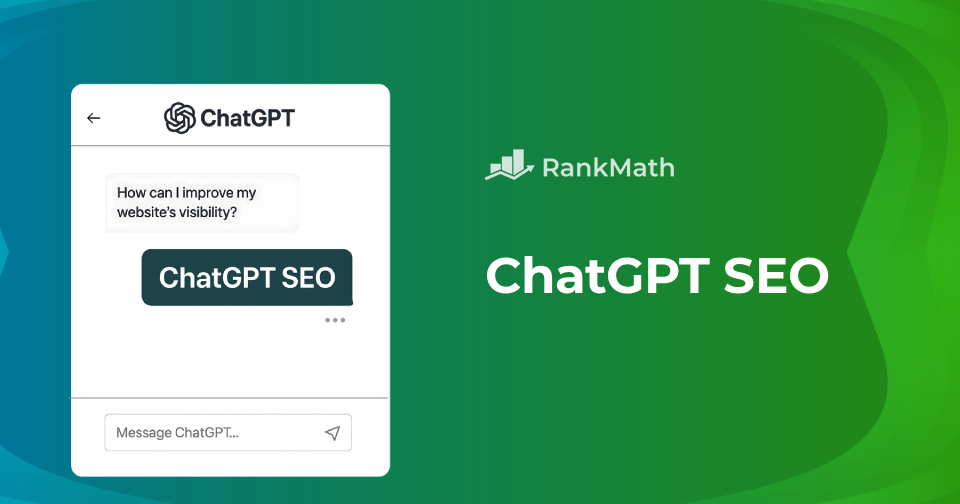Getting your brand, product, or service mentioned in ChatGPT answers takes more than keywords or traditional SEO. ChatGPT relies on patterns in how it selects, ranks, and cites sources, and understanding these patterns is key to achieving visibility.
Most guides stop at the basics, so we ran deeper tests. We queried ChatGPT directly, reviewed every cited source, and tracked which pages consistently influenced its answers.
We compared results across Google and Bing to see how live data, authority signals, and search intent shape what ChatGPT pulls in. Surprisingly, we also found that older, but well-optimized content still appears.
These insights cut through the noise and show how ChatGPT SEO really works. In this article, you’ll learn practical steps to position your pages so your brand or product has a higher chance of being mentioned.
To see exactly how we conducted this research, watch the video below.
Table Of Contents
- What is ChatGPT SEO?
- Key Strategies of ChatGPT SEO— Get Your Brand Mentioned on ChatGPT
- Get Your Site Indexed by Bing
- Align Your Content with Search Intent and Market
- Do Not Block Essential AI Crawlers
- Build and Maintain Strong, Main-Cited Sources
- Create a Content Ecosystem That Signals Authority
- Update Your Content Frequently
- How ChatGPT Actually Finds and Chooses Content
- Frequently Asked Questions
- Conclusion
1 What is ChatGPT SEO?
ChatGPT SEO is the process of optimizing your content so it has a higher chance of being cited or mentioned when ChatGPT generates answers.
Unlike traditional SEO, which focuses on ranking in search engines, ChatGPT SEO is about aligning with how ChatGPT selects, organizes, and references sources.
From our research, ChatGPT doesn’t just pull from the top of search results. It considers a mix of factors:
- Freshness: pulling from live or recently updated sources.
- Authority: giving weight to domains or pages that are consistently cited.
- Relevance: matching content closely to user intent.
- Durability: still answering from older, high-quality content when relevant.
In short, ChatGPT SEO bridges traditional search optimization with conversational AI, helping your brand, service, or product show up in ChatGPT answers.
2 Key Strategies of ChatGPT SEO— Get Your Brand Mentioned on ChatGPT
These strategies form the core of ChatGPT SEO and demonstrate how to effectively increase the likelihood of your brand or product being cited in ChatGPT answers.
2.1 Get Your Site Indexed by Bing
The first step is to ensure your site is indexed by Bing, as ChatGPT relies heavily on it for its web data.
Being indexed means ChatGPT can access your content, analyze it, and potentially include your brand, products, or services in its answers. Without indexing, other strategies won’t matter.
To get started, submit your site to Bing Webmaster Tools and make sure it’s fully crawlable. Check regularly to confirm your pages are being indexed and that nothing like robots.txt restrictions is blocking access.
For more details, refer to our step-by-step guide on getting your site indexed in ChatGPT.
2.2 Align Your Content with Search Intent and Market
When we first looked at how ChatGPT lists products, we assumed it would prioritize the items mentioned most often across sources.
Turns out, frequency isn’t the main factor. ChatGPT also weighs the intent behind the search and the audience it’s meant for.
For example, a query like “best apps for managing expenses” might seem to favor enterprise tools, but ChatGPT often prioritizes options suited for individuals or small businesses.
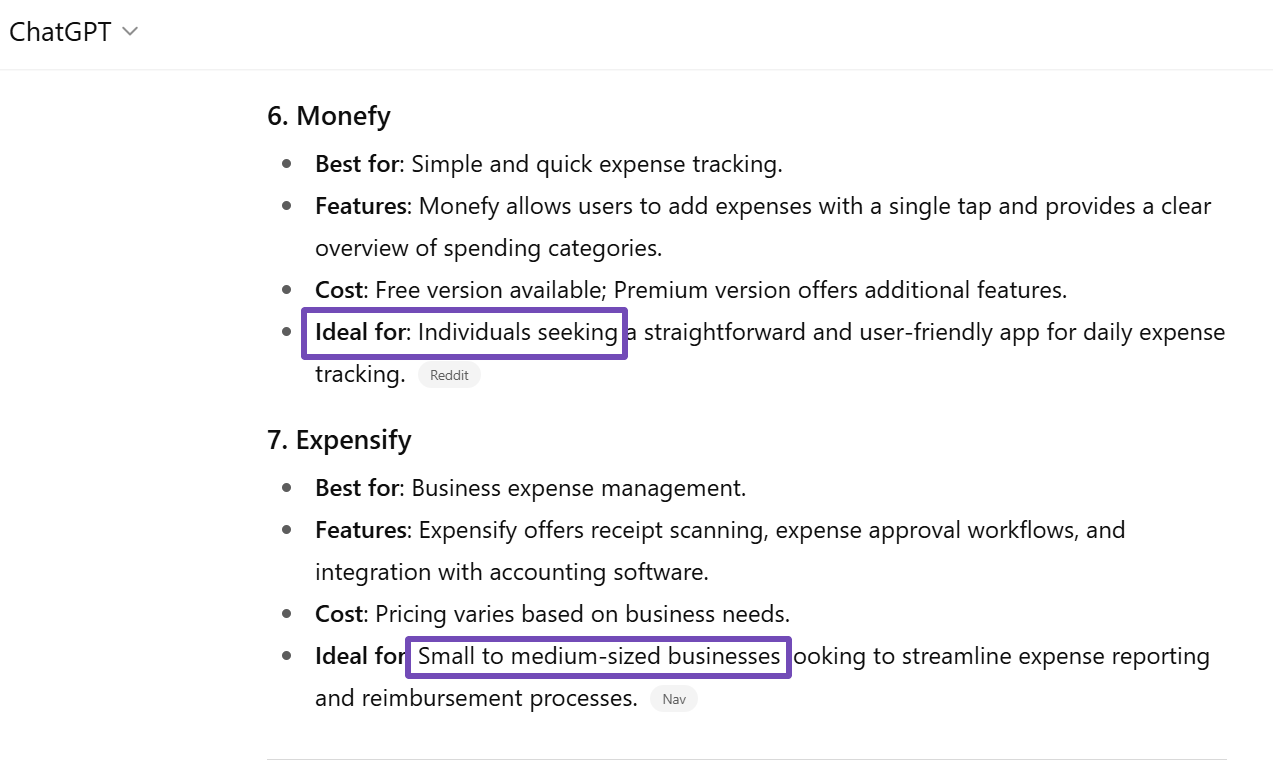
What does this mean for your content? To get your product or brand mentioned in ChatGPT, your pages need to clearly communicate who they’re for and what problems they solve.
Understanding Your Audience’s Intent
ChatGPT organizes products by categories like personal use or business use. It filters results to match what the user likely wants.
So if your product is designed for enterprises, but the query implies personal use, it might not appear unless your target audience is explicit on your pages.
Clearly state your audience and use cases on your product and service pages. Highlight whether it’s for individuals, small businesses, or larger teams.
Creating Intent-Specific Content Pages
If your product serves multiple groups, consider creating separate pages for each segment. The content doesn’t need to be drastically different; it just needs to be tailored to the audience’s needs and language.
For example, here at Rank Math, we might create pages like:
- Best WordPress SEO Plugin for Small Businesses
- Free WordPress SEO Plugin for Local Businesses
- WordPress SEO Plugin for Multiple Location Businesses
Combining Traditional SEO with AI Visibility
Although traditional SEO favors one comprehensive article, ChatGPT prefers pages tailored to specific query intents.
Having separate, focused pages increases your chances of your brand being cited in ChatGPT.
Therefore, use canonical tags to signal the main page to Google while letting AI platforms see the audience-specific variations. Here’s how to do it in Rank Math:
In Rank Math, this is simple. Copy the URL of your main comprehensive page, then go to each intent-specific page and open the Rank Math meta tab in your editor.
Under the Advanced tab, keep the page indexed, but paste your main page URL in the Canonical URL field. Do this for all variations so that Google understands which page is the primary one.
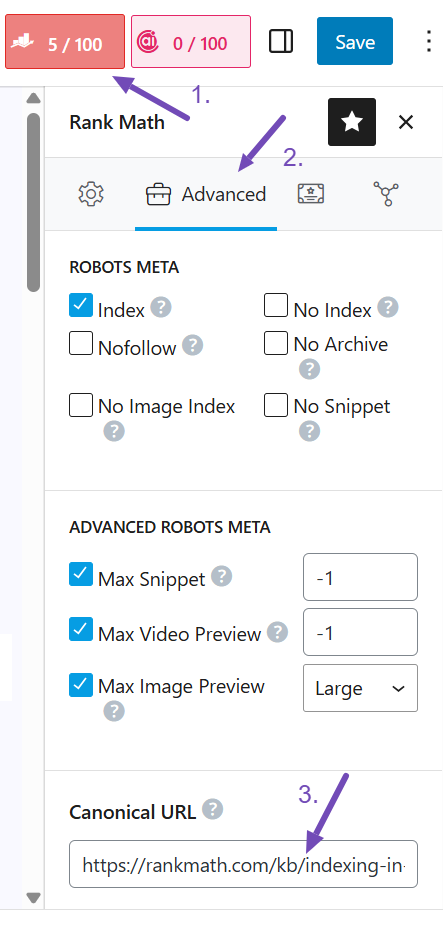
The key takeaway? ChatGPT doesn’t just count mentions. It analyzes intent. The more accurately your content matches what users are searching for, the higher the chance your product, service, or brand will be mentioned in ChatGPT’s answers.
2.3 Do Not Block Essential AI Crawlers
If you want your brand mentioned in ChatGPT, one of the most important steps is to make sure its crawlers can access your site. OpenAI uses three main crawlers:
- OAI Search Bot – helps ChatGPT Search index websites
- ChatGPT User – assists in pulling live information for ChatGPT answers
- GPTBot – crawls the web and trains ChatGPT’s AI model
At first, it might seem wise to block GPTBot if you don’t want your content used for AI training. But here’s the catch: allowing GPTBot actually works in your favor. ChatGPT often references content from its trained knowledge, which includes older but still relevant sources.
For instance, when we searched for the best website builders for small business owners, one of the cited sources was Tech Advisor.
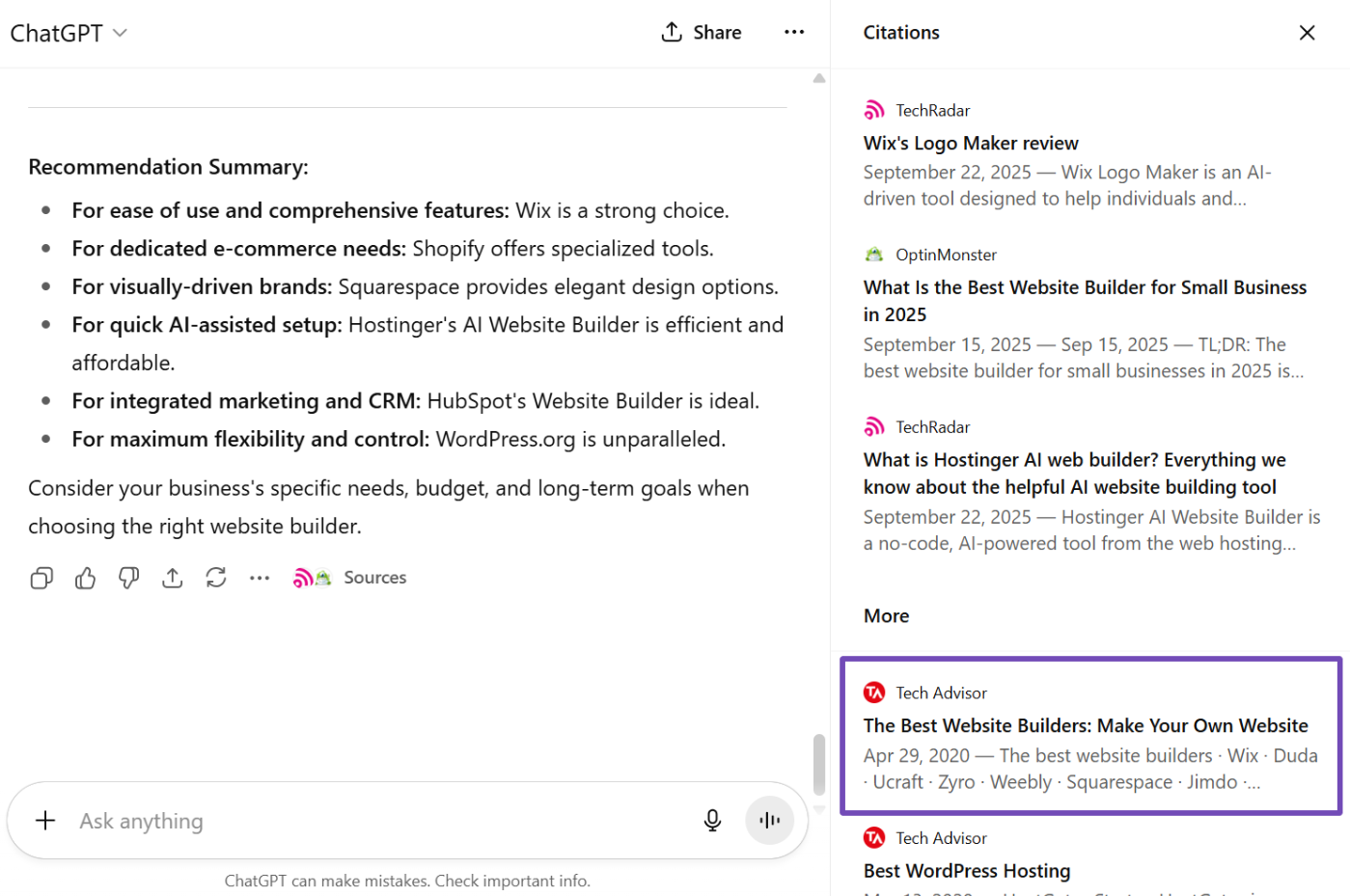
However, when we attempted to find that same page on Google and Bing, it wasn’t there. That’s because ChatGPT supplements live search results with trusted older content from its training data, which is updated up to 2024.
This highlights why having your content included in ChatGPT’s training data matters. A strong presence boosts your chances of being mentioned in answers.
How to Ensure AI Crawlers Can Access Your Site
If you’re using Rank Math, checking and updating your robots.txt file is simple. Just head to Rank Math SEO → General Settings, open the Edit robots.txt editor, and confirm that GPTBot and other OpenAI crawlers aren’t blocked. Once you’ve verified, save your changes.
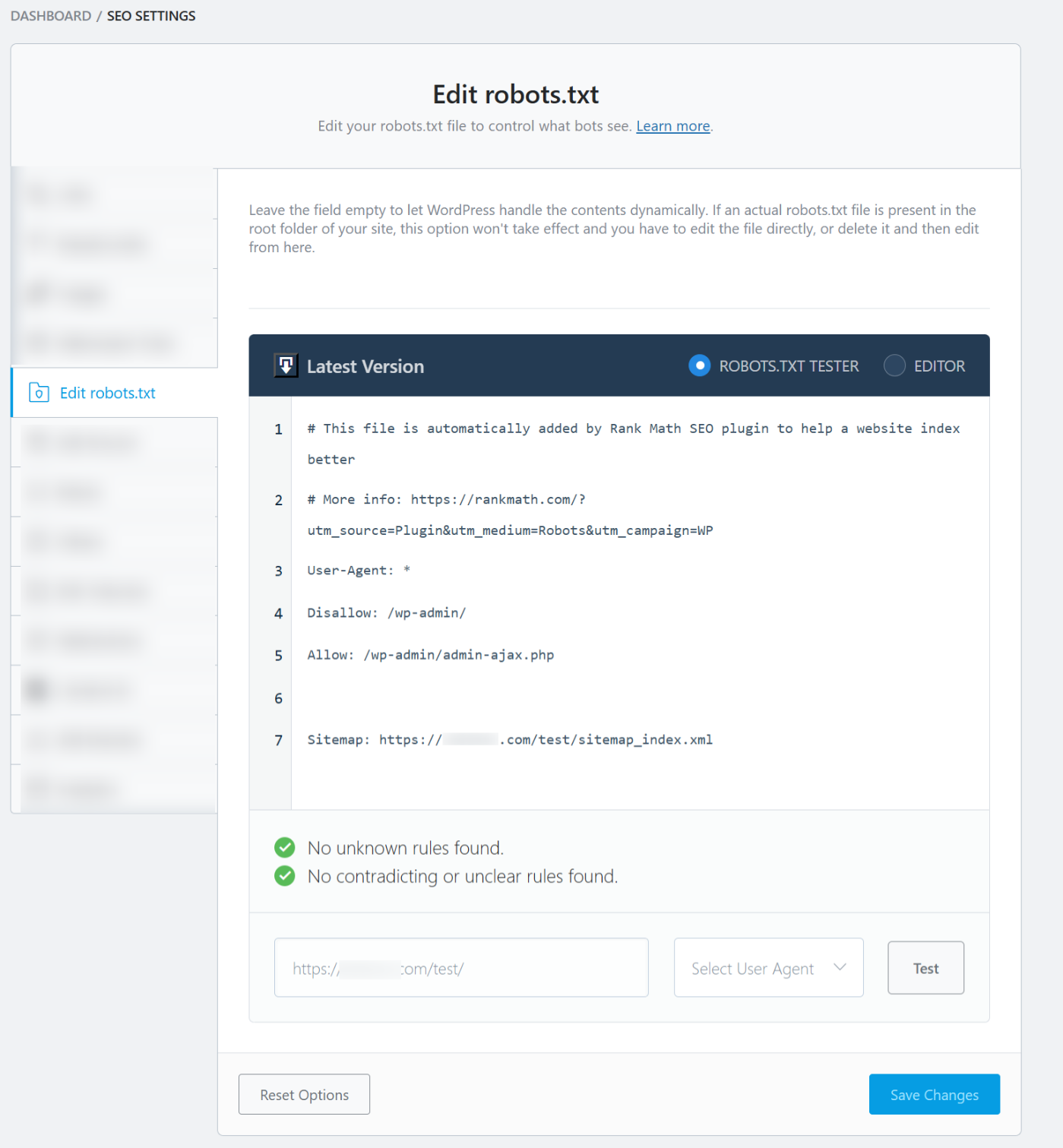
By doing this, you ensure that your content can be utilized in both ChatGPT’s live answers and its training model, giving your brand a significantly stronger chance of being mentioned.
2.4 Build and Maintain Strong, Main-Cited Sources
ChatGPT organizes its sources into two groups. If your brand appears in the main-cited sources, your chances of being included in an answer are much higher. Search intent matters, but being in the main-cited sources is key.
When checking any ChatGPT answer, scroll to the bottom and click the Sources button. The first set of citations is the main group, while the second set appears under the More section.
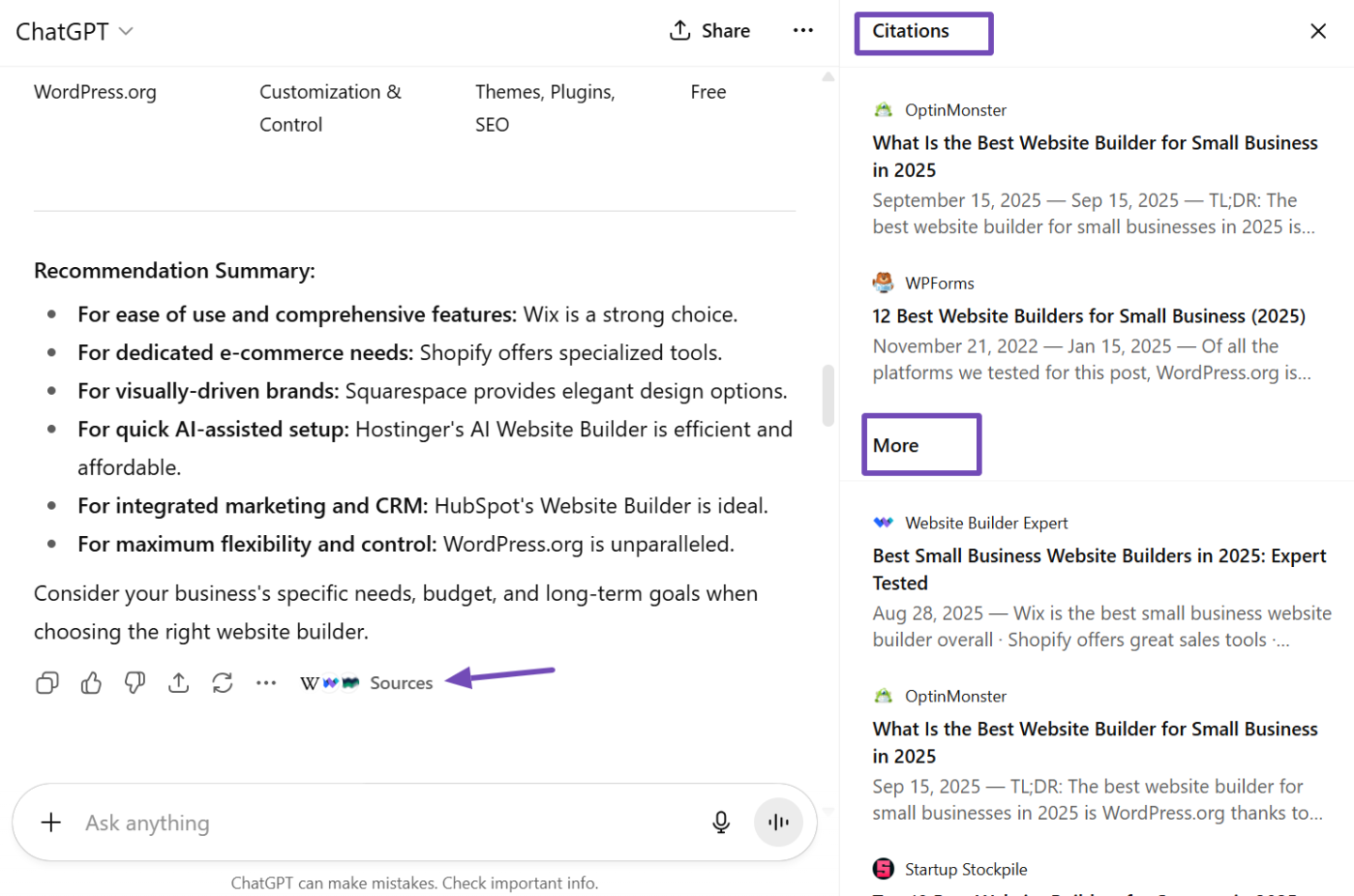
Our analysis showed that 100% of the products or brands included in ChatGPT’s answers are cited in the main group. None appears without being in this main set.
ChatGPT confirmed that these main-cited sources are considered authoritative and trustworthy enough to shape its answers.
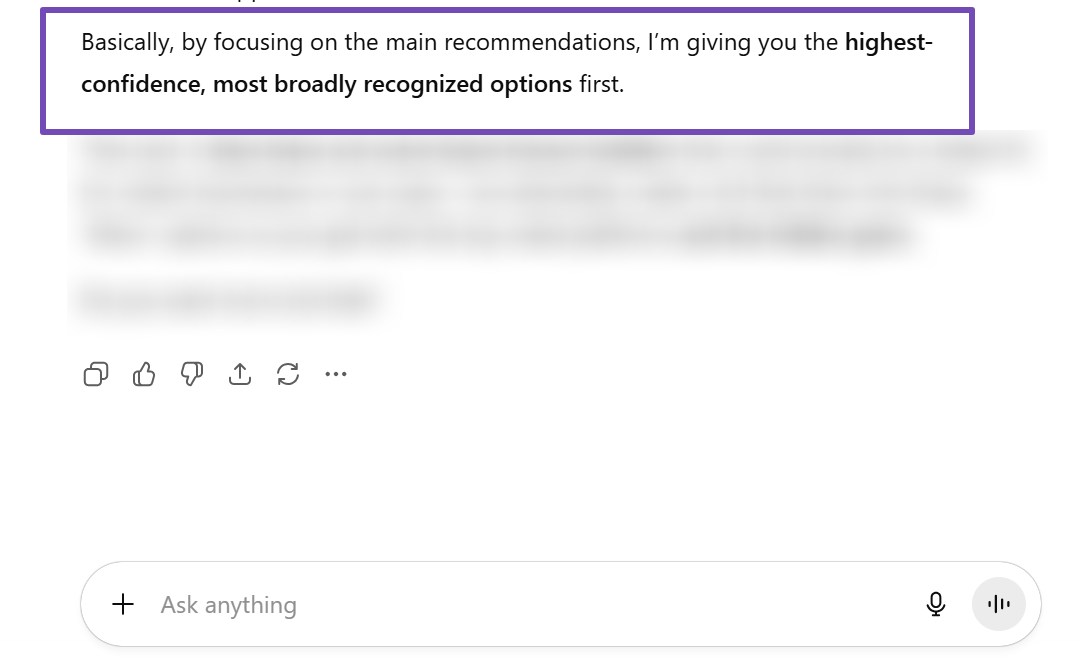
Here’s what you can do to get your brand into the main-cited sources:
- Identify high-authority sites relevant to your niche.
- Ensure your brand appears on these high-authority sites via partnerships, reviews, or guest posts.
- Focus on creating high-quality content and offering unique insights that truly set your brand apart.
This is one of the most direct applications of ChatGPT SEO. It helps you earn spots in authoritative sources, so that ChatGPT consistently mentions your product.
2.5 Create a Content Ecosystem That Signals Authority
Here’s something interesting we found: most pages in ChatGPT’s main-cited sources come from high-authority sites, but many of them aren’t even on page one of Google or Bing. Some appear on pages three, five, seven, or even ten.
This shows that site authority matters more than search rankings when it comes to being referenced by ChatGPT.
How to Build Authority Across Platforms
The best way to grow authority isn’t by asking for backlinks. Instead, focus on creating unique, valuable content:
- Publish research papers or proprietary data to prove your expertise.
- Create case studies showing why your product or service delivers results.
- Expand beyond written content. Use podcasts, YouTube, Instagram reels, and other platforms where your audience is active. Visibility across these channels builds authority.
Why Context Matters in Mentions
ChatGPT also looks at how your brand is mentioned. A single mention can carry weight if the context shows authority. For example, a source that not only lists a product but also positions it as a credible solution strengthens its influence.
Relying solely on third-party mentions isn’t enough. Create your own content, such as guides or listicles, to boost credibility and increase the chances of being cited in ChatGPT’s main sources.
In short, building a strong content ecosystem and providing authoritative, context-rich mentions boosts your brand’s visibility, influence, and chances of being referenced by AI platforms.
2.6 Update Your Content Frequently
Our research revealed that 86% of ChatGPT’s main-cited sources were written or updated in the same year, while the remaining 14% originated from its trained knowledge. Ahrefs confirmed this trend as well.
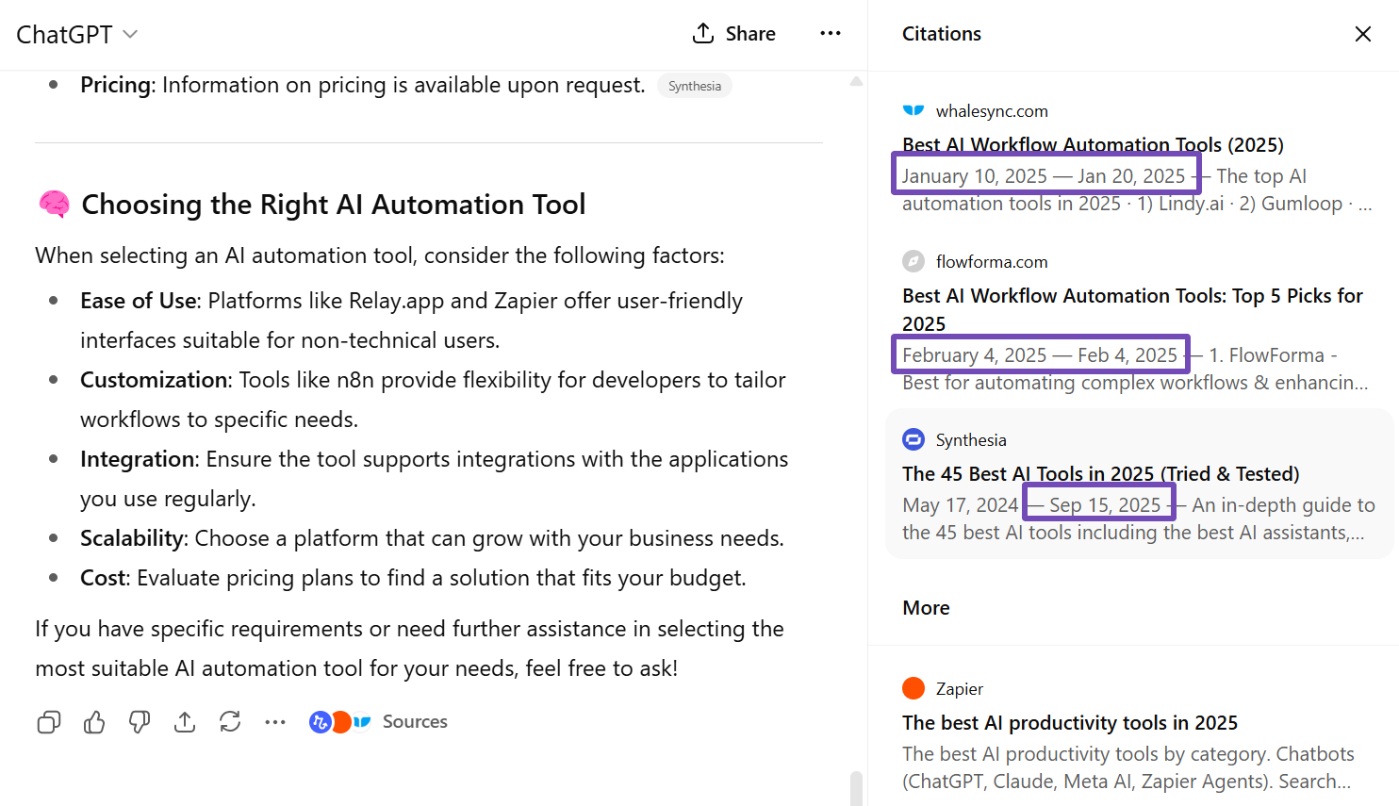
This tells us one thing: fresh, relevant content matters. Instead of endlessly creating new articles, focus on updating your existing content at least once a year. Keep the information accurate, current, and aligned with what your audience is searching for.
So here are some steps to update your content
- Review your top-performing pages from the past year and verify that they are up to date.
- Add new insights, stats, or examples that make the content relevant to today’s audience.
- Optimize titles, headings, and meta descriptions to match current search intent.
- Verify internal links and references to ensure they all point to updated resources.
- Republish or update the publish date to signal freshness to both search engines and AI platforms.
Keeping content updated signals relevance and authority, increasing the chance of being cited.
3 How ChatGPT Actually Finds and Chooses Content
By now, you might be wondering how ChatGPT decides which brands, products, or services to mention. To gain a clear picture, we conducted a test using a recent topic: “best AI tools that can generate 3D environments.”
This topic was mainly outside ChatGPT’s 2024 training data.
What we found is interesting. ChatGPT didn’t just pull information from Google or Bing. It also referenced academic papers and other authoritative sources that weren’t even ranking on traditional search engines.
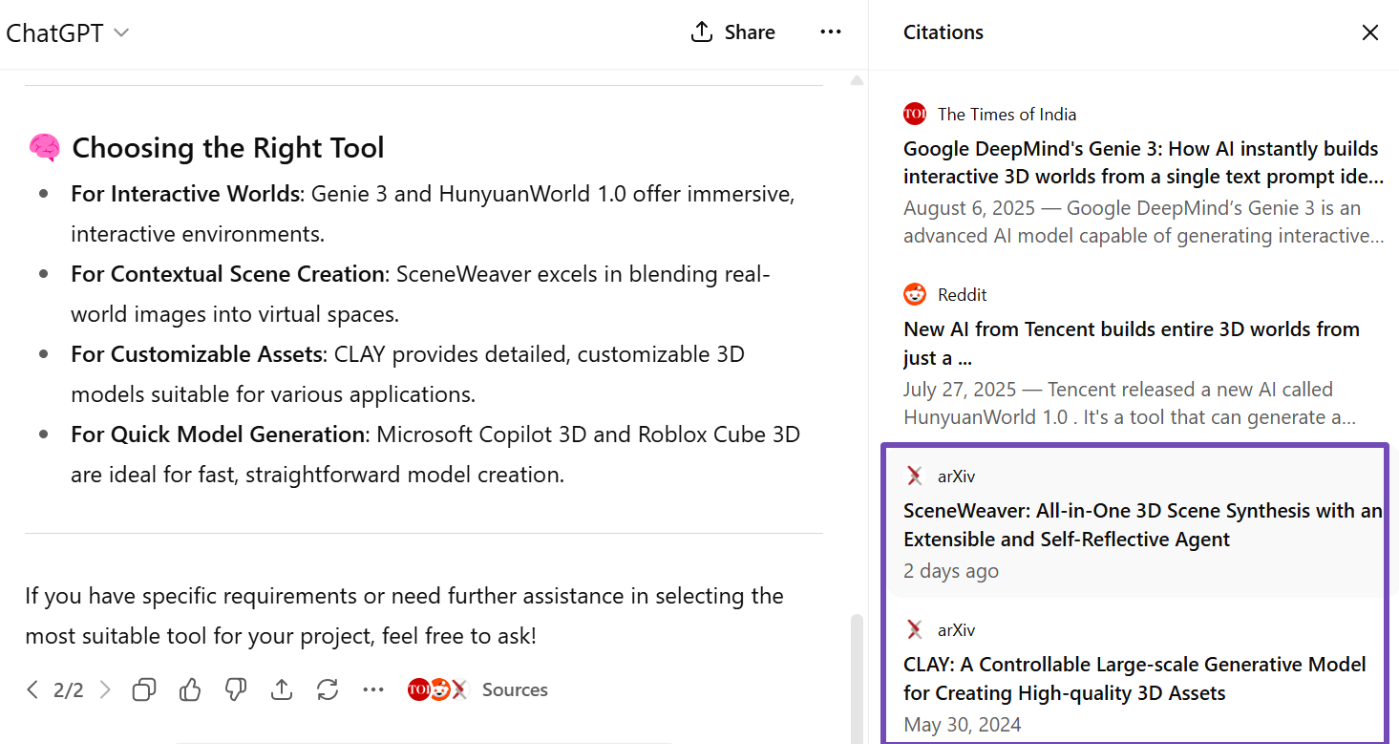
For fast-moving topics, ChatGPT goes beyond standard search results for reliable information.
Here’s how ChatGPT sources and filters content:
- Gather from traditional search engines: It checks Google, Bing, and other search results to see what’s publicly available. This gives a basic landscape, though it can include recycled information or marketing claims.
- Consult research sources: If search results aren’t enough, it dives into academic papers, journals, manufacturer listings, and other high-quality sources.
- Filter for relevance: The content must match the query intent exactly. Even if your page isn’t ranking high on search engines, it can still be considered if it aligns with the question.
- Personalize answers: ChatGPT prioritizes products or solutions based on the implied audience. For instance, queries like “best apps” favor tools for individuals or small businesses over enterprise solutions.
- Cross-check information: It verifies details across multiple sources to ensure accuracy and reliability.
- Reference trained knowledge: Finally, it uses its own training data to supplement results and fill any gaps.
The bottom line? Ensure your content is relevant, clearly communicates its use case, and appears on authoritative sources.
That’s how you align with the way ChatGPT filters and cites information, boosting your chances of having your brand mentioned in ChatGPT.
4 Frequently Asked Questions
How can I monitor my brand’s visibility in ChatGPT?
Run relevant queries regularly and check which of your pages appear and whether they’re main-cited. Track this over time to see how often ChatGPT mentions your brand.
Does ChatGPT consider social media mentions?
Not directly. But mentions on credible sites or widely shared content can boost authority, indirectly increasing your brand’s chances of being cited.
Is it necessary to use specific keywords to be mentioned by ChatGPT?
Not exactly. ChatGPT focuses on intent and context. Clear messaging about who your content is for and what problem it solves matters more than keyword frequency.
How can I optimize my content for both Google and ChatGPT?
Align with user intent, structure content clearly, build authority through credible mentions, and update regularly. Combine this with traditional SEO basics like titles and meta descriptions.
What are the best practices for creating content that ChatGPT will cite?
Target clear intent, include your brand naturally, get cited by authoritative sources, update content frequently, and expand with guides, research, or case studies.
5 Conclusion
ChatGPT SEO goes beyond traditional search. It is about positioning your content so your brand or product is naturally cited in ChatGPT’s answers.
The key is to serve clear human intents and be part of the trusted sources ChatGPT relies on. That means creating focused, high-quality pages, keeping your data fresh and authoritative, and building a broad authority footprint through original content.
Start small: audit your content, optimize for intent, open access to essential crawlers, and strengthen your authority signals.
Over time, these steps build visibility, credibility, and influence not only in search results but also in AI-driven answers.
What strategies have you used to get your brand mentioned in ChatGPT? Share your thoughts by Tweeting @rankmathseo.
